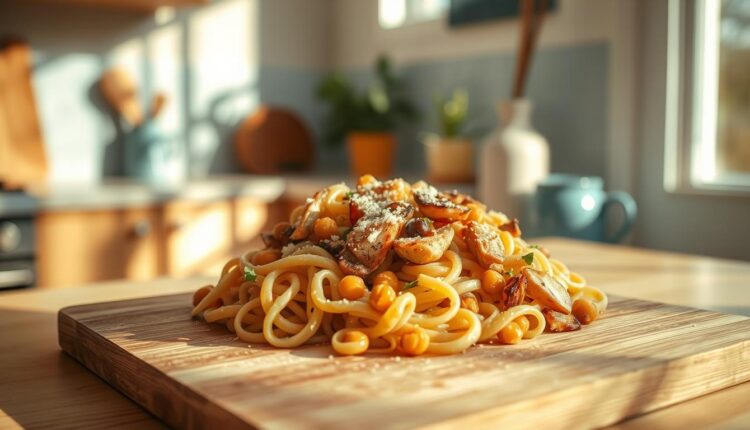High Protein Lunch Prep Pasta With Protein Additions
Transform your lunches with high protein lunch prep pasta. Follow our how-to guide for easy meal prep, protein-packed additions, and no-stress meals.
As someone who’s burned countless batches of rushed lunches while juggling recipe testing and parenting, I’ve learned one truth: the right dish can turn chaos into calm. That’s why I created this make-ahead marvel—a customizable base that transforms into five distinct meals with simple protein swaps.
This formula solves two universal kitchen headaches: bland repetition and last-minute scrambling. By combining hearty noodles with nutrient-rich add-ins, you’ll build satisfying bowls that keep energy steady through afternoon meetings or soccer practices. The best part? Everything comes together during one Sunday session.
- Versatile base recipe adapts to chicken, beans, or tofu
- Pre-portioned containers streamline grab-and-go mornings
- Flavor boosters prevent “meal prep boredom”
From my Asheville kitchen to yours, this system respects real life. Forgot to thaw the shrimp? Use canned tuna instead. Kids refusing greens? Blend spinach into the sauce. Here’s how to create lunches that work smarter—not harder—for your unique week.
The Power of High Protein Lunch Prep Pasta
After years of scrambling to assemble midday meals between client calls and school runs, I discovered a game-changing truth: smart kitchen systems beat willpower every time. This adaptable base dish solves the “hangry” 2 PM crash with balanced flavors and lasting fuel.

Why Protein Matters for Your Lunch
Think of your noontime plate as a productivity tool. Lean proteins like grilled chicken or chickpeas slow digestion, keeping energy steady through back-to-back meetings. They also help rebuild muscles after morning workouts. Pair them with complex carbs from whole-grain noodles, and you’ve got a plate that works as hard as you do.
Quick and Easy Meal Prep Benefits
Sunday’s 45-minute prep session eliminates weekday guesswork. Cook once, then mix-and-match toppings for variety. Store portions in glass containers—they’ll stay fresh for 4 days. Need a faster option? Keep cooked proteins frozen for last-minute assembly.
| Task | Daily Cooking | Weekly Prep |
|---|---|---|
| Active Time | 25 mins/day | 45 mins/week |
| Dish Variety | Limited | 5+ combinations |
| Stress Level | High (daily decisions) | Low (grab & go) |
This approach isn’t about perfection—it’s about progress. Forgot to roast veggies? Toss in frozen peas. Swap sauces weekly to keep taste buds engaged. Your future self will thank you when Thursday’s lunch is ready before the coffee brews.
Ingredient Breakdown: Pasta, Protein, and Flavor Boosters
Choosing the right building blocks makes all the difference between a forgettable dish and a lunch you crave. Through trial and error (and one memorable incident involving overcooked noodles), I’ve identified three key components that transform basic bowls into satisfying meals.
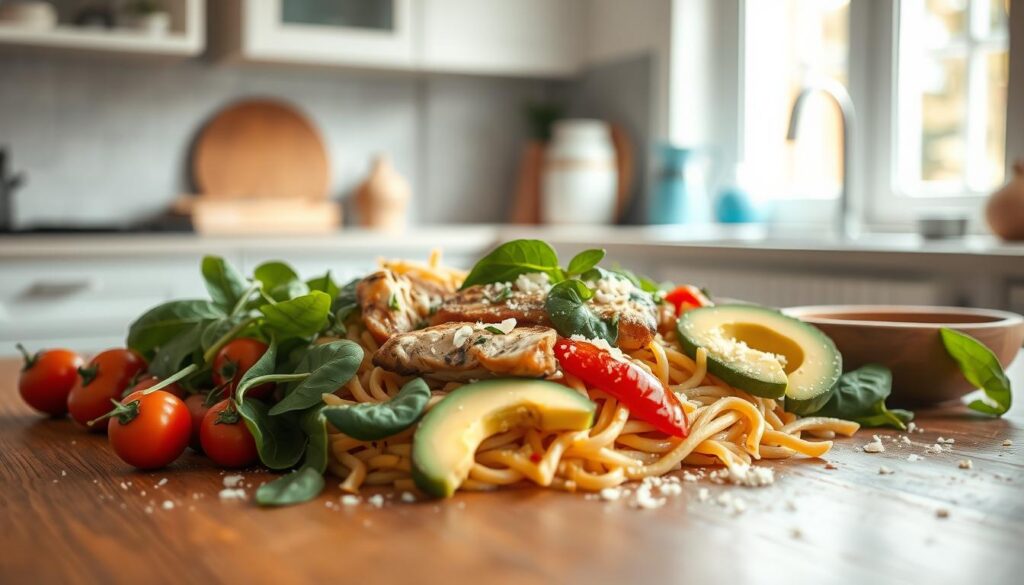
Essential Pasta Types and Alternatives
Not all noodles are created equal. Whole wheat varieties offer extra fiber, while chickpea-based options pack 14g of plant-powered fuel per serving. For gluten-free needs, try lentil or brown rice versions—they hold sauce beautifully without turning mushy.
| Type | Protein per Serving | Best For |
|---|---|---|
| Whole Wheat | 7g | Classic texture lovers |
| Chickpea | 14g | Plant-based diets |
| Lentil | 13g | Gluten-free needs |
| Zucchini Noodles | 2g | Low-carb options |
Exploring Protein Options
Rotisserie chicken saves time, but don’t sleep on canned salmon or marinated tofu. For vegetarians, chickpeas roasted with smoked paprika become crispy flavor bombs. My secret? Always keep frozen edamame on hand for last-minute additions.
Sun-dried tomatoes or a spoonful of pesto can revive even the simplest combinations. Fresh basil adds brightness, while chili flakes bring heat without extra calories. Remember: Great meals aren’t about fancy ingredients—they’re about smart pairings.
Gathering Your Tools and Equipment
We’ve all been there—standing in a kitchen cluttered with mismatched lids and dull knives, wondering why dinner took twice as long as planned. Through years of mid-recipe equipment hunts (and one memorable incident with a warped pan), I’ve learned that your tools can make or break meal prep efficiency.
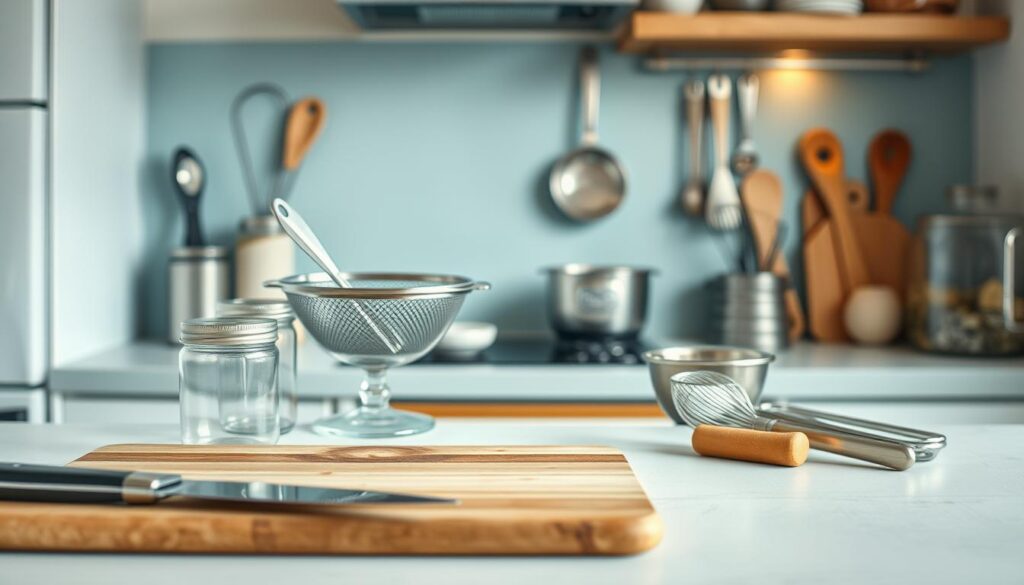
Must-Have Kitchen Tools for Meal Prep
Start with these essentials to transform chaotic cooking into smooth sessions:
| Tool | Purpose | Priority |
|---|---|---|
| 12″ Non-Stick Pan | Even cooking without food sticking | Essential |
| 6-Qt Stockpot | Boiling noodles & batch cooking | Essential |
| Glass Containers | Portion storage & reheating | High |
| Sharp Chef’s Knife | Quick veggie prep | High |
That non-stick surface? It’s your best friend when sautéing veggies or reheating proteins. Pair it with a sturdy pot that maintains steady heat—no more half-cooked noodles in the center while edges turn mushy.
Don’t underestimate quality olive oil. A good bottle enhances flavors better than cheaper oils and helps prevent sticking. Keep it within arm’s reach during cooking sessions.
Having your tools ready before starting eliminates the “where’s the lid?” scramble. Wash and dry containers while noodles boil. Sharpen knives while proteins marinate. Follow recipe instructions step-by-step, and you’ll finish before the oven preheats.
Step-by-Step Guide to Preparing High Protein Lunch Prep Pasta
I’ll never forget the time I served my husband what he lovingly called ‘noodle cement’—a tragic mix of overcooked spaghetti and grainy sauce. That kitchen disaster taught me precision matters. Let’s walk through the process that’ll give you fork-tender results every time.
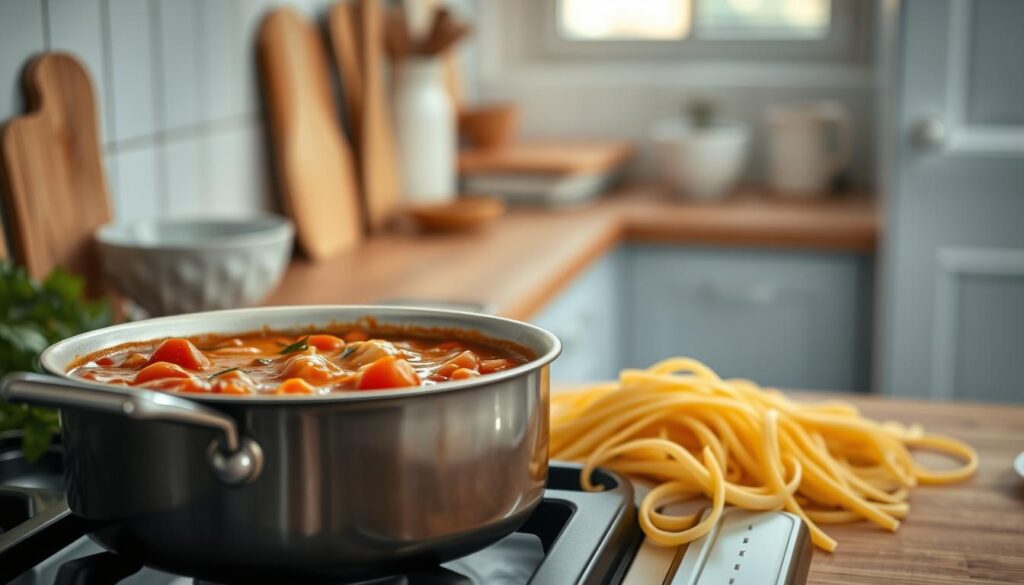
Mastering the Al Dente Bite
Fill your largest pot three-quarters full with cold water—this gives noodles room to dance. Add a palmful of salt once bubbles appear, then stir in your chosen shape. Set a timer for 2 minutes less than package instructions suggest. Test doneness by pressing a piece against the counter: it should bend slightly without snapping.
Sauce That Clings Like a Hug
While noodles drain, grab that still-warm pot. Sauté minced garlic in residual heat for 15 seconds—just until fragrant. Reduce the burner to low, then whisk in cream cheese and a splash of starchy cooking water. Pro tip: Let the mixture sit off-heat for 30 seconds before stirring to prevent curdling.
Gently fold drained noodles into the sauce. If it thickens too much, add water 1 tablespoon at a time. You’re aiming for a velvety coating that leaves trails when you drag a spoon through it. Taste and adjust with black pepper or lemon zest.
This method turns basic ingredients into something special. Once cooled, portion into containers and refrigerate. Come Wednesday, you’ll have a creamy base ready for roasted veggies or shredded chicken.
high protein lunch prep pasta: Mastering the Technique
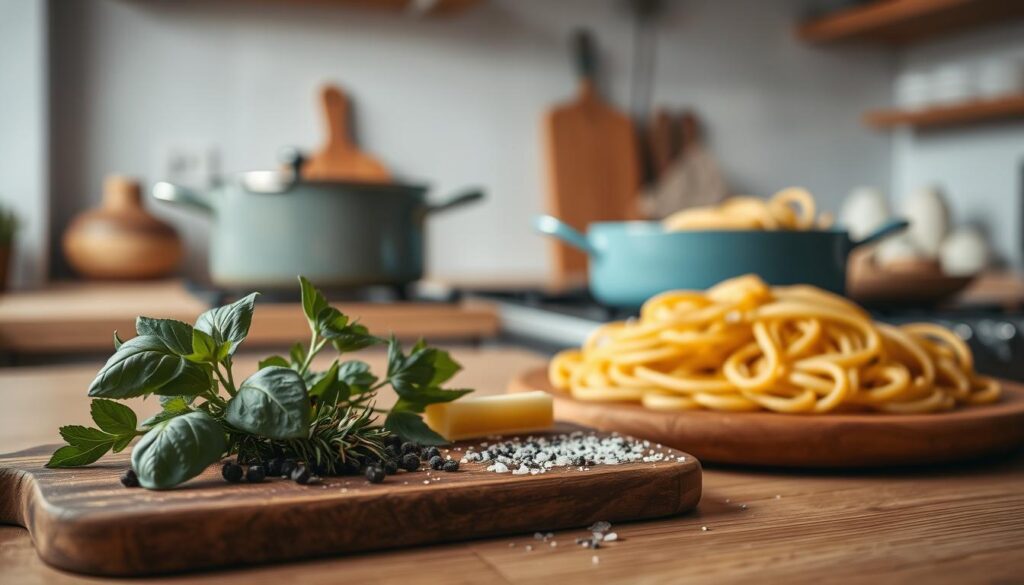
I once ruined three batches of fusilli trying to impress my food critic neighbor—until her simple advice changed everything: “Treat your noodles like thirsty sponges.” This revelation transformed my approach to building depth in every bite.
Start with cold water and a generous pinch of salt. As bubbles form, stir in your chosen shape. For whole-grain varieties, subtract 90 seconds from package times. Test doneness by pressing a piece to your tongue—it should stick slightly before releasing.
Season in layers:
- Toss warm noodles with ½ tsp salt immediately after draining
- Mix seasoning blends into sauces rather than sprinkling on top
- Finish with a citrus squeeze or vinegar to brighten flavors
That one-pot method from my test kitchen days? It’s gold for busy cooks. Simmer noodles directly in broth with garlic and herbs. The starch creates instant sauce while infusing every strand. Bonus: Fewer dishes to wash.
Last week, my daughter declared my lemon-herb version “better than takeout” after I adjusted the cook time by two minutes. That extra bite made all the difference. Remember—great recipes aren’t rigid. Taste as you go, and don’t fear the salt shaker when balancing flavors.
Incorporating Protein Additions for a Nutrient Boost
Last Thanksgiving, I faced twelve hungry relatives and one pan of naked noodles—until I remembered the power of intentional protein pairing. Whether you’re fueling marathon workdays or chasing toddlers, strategic additions turn simple carbs into sustaining meals.
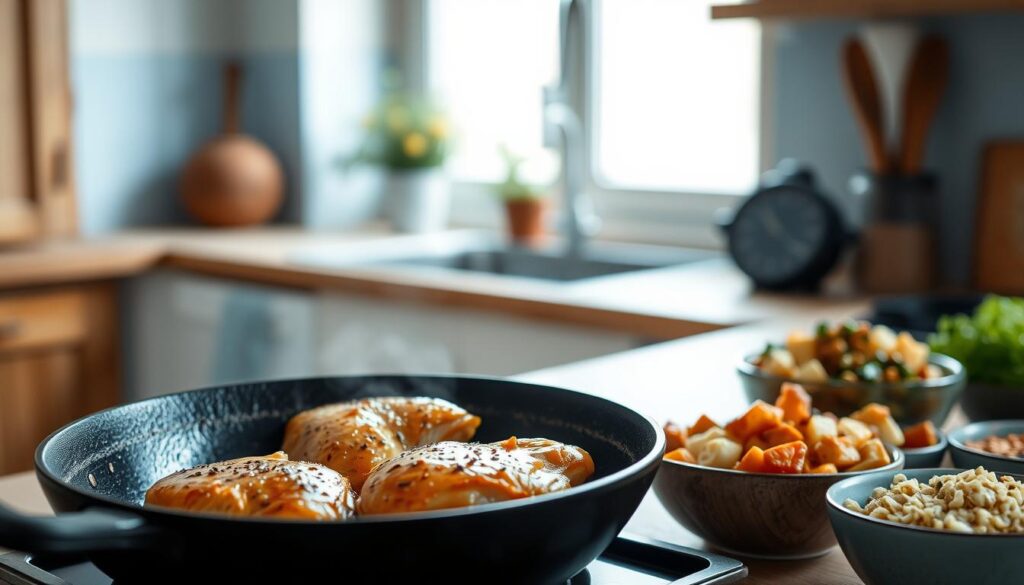
Seasoned Chicken and Beyond
My Cajun-spiced shredded chicken became a reader favorite after surviving three soccer tournaments. The secret? Marinate overnight in smoked paprika and garlic, then bake at 425°F until edges crisp. Key move: Reserve pan drippings to toss with noodles—they carry flavor without extra fat.
Plant-Based Protein Alternatives
For meat-free Mondays, try this trick from my vegan sister: press tofu between plates for 20 minutes, cube, then roast with nutritional yeast. Legumes shine when treated like stars—simmer lentils in broth before folding into warm noodles.
- Balance salt and pepper ratios: ¼ tsp kosher salt per cup of cooked protein
- Mix fats wisely—a drizzle of tahini or avocado oil boosts absorption
- Prep proteins Sunday night using this flavor matrix:
| Protein | Seasoning Blend | Cook Time |
|---|---|---|
| Chicken Breast | Cumin + Garlic Powder | 22 mins |
| Chickpeas | Turmeric + Black Pepper | 15 mins |
| Tempeh | Maple + Soy Sauce | 12 mins |
Last week, a client swapped shrimp for baked beans in her dish—proof that flexibility creates kitchen wins. Your turn: choose one new protein this week and note how it changes your midday energy.
Enhancing Flavor with Veggies, Herbs, and Seasonings
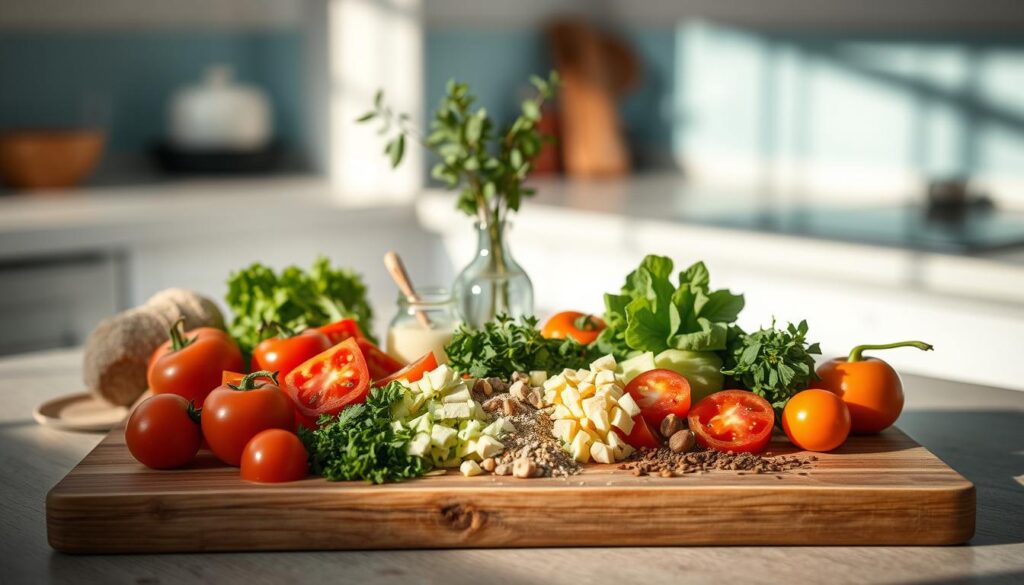
My neighbor once returned a container of my “famous” zucchini noodles, whispering, “Callie, these taste like rainboots.” That humbling moment taught me vegetables deserve more than last-minute treatment. Let’s explore how intentional prep turns them into flavor heroes.
Start with crisp, colorful produce. Look for firm bell peppers with glossy skin and broccoli florets that snap when bent. For sauces, choose plum tomatoes—their low moisture content creates rich texture without watering down your dish.
Tips for Selecting Fresh Vegetables
Roasting concentrates natural sugars, while quick-pickling adds tang. Try this method for weeknight-friendly veggies:
| Vegetable | Prep Method | Flavor Pairing |
|---|---|---|
| Cherry Tomatoes | Halved & roasted | Basil + Balsamic |
| Spinach | Wilted in garlic oil | Nutmeg + Lemon |
| Zucchini | Spiralized raw | Mint + Feta |
For creamy sauces without heaviness, whisk ¼ cup milk into reduced-sodium broth. It adds richness while keeping calories in check. Pro tip: Warm the milk first to prevent curdling.
“I never liked kale until I massaged it with lemon juice—now it’s my salad star!”
Chiffonade fresh herbs just before serving to release aromatic oils. Store washed greens in linen-lined containers—they’ll stay crisp for three days. Remember: Vibrant veggies don’t just nourish—they make your dish Instagram-ready before you snap the lid.
Time-Saving Meal Prep and Batch Cooking Strategies
Between client deadlines and my daughter’s flute recitals, I’ve burned more weekday dinners than I’d care to admit—until I cracked the code on strategic batch cooking. This system turns Sunday’s effort into five days of stress-free meals without compromising flavor or nutrition.
Efficient Cooking and Storing Methods
Start with your largest stockpot to cook 4-6 cups of noodles—enough for 4-5 servings. Drain while slightly undercooked (they’ll soften during reheating). Toss with a teaspoon of olive oil to prevent clumping. For balanced meals, measure ½ cup of fiber-rich veggies like roasted broccoli per portion using dry measuring cups.
Store in single-serve glass containers with these layers:
- Base: 1 cup noodles
- Middle: ¾ cup protein + veggies
- Top: Sauce separated in small reusable pouch
When reheating dinner portions, sprinkle 1 tablespoon of water over the bowl before microwaving. Cover loosely to steam evenly without drying out. Game-changer: Add a pinch of pepper or chili flakes after heating to refresh flavors.
| Storage Method | Freshness | Reheat Time |
|---|---|---|
| Glass Containers | 4 days | 2 mins |
| Freezer Bags | 3 months | 4 mins |
“Prepping sauces in ice cube trays changed my week—I grab exactly what I need!”
For faster clean-up, cook proteins and veggies in the same pan used for noodles. Wipe with a damp cloth while warm—no scrubbing required. Want more variety? Explore our flavor-packed seasoning blends to keep your taste buds engaged all week.
Customizing Your Dish for Dietary Preferences
When my niece was diagnosed with celiac disease, our family pasta nights needed a reboot—fast. Through trial and error (and one memorable “crunchy noodle” incident), I discovered how simple swaps can keep everyone at the table happy. Whether you’re avoiding gluten or exploring plant-based eating, flexibility is your friend.
Navigating Alternative Noodle Choices
Chickpea varieties cook faster than traditional options—check packages closely. Reduce boil time by 1-2 minutes to prevent mushiness. For heartier textures, try lentil-based shapes. They hold up well in chicken pasta bakes or chilled salads.
| Pasta Type | Cook Time | Seasoning Tip |
|---|---|---|
| Chickpea | 7 mins | Add ¼ tsp salt to water |
| Brown Rice | 9 mins | Rinse after draining |
| Quinoa Blend | 6 mins | Boost with garlic powder |
Time-crunched? Pre-cook alternative noodles Sunday night. Toss with olive oil and refrigerate—they’ll reheat beautifully. For creamy dishes, blend cashews into sauces instead of dairy. It adds richness without gluten concerns.
“Swapping regular noodles for chickpea pasta gave my lunches new life—plus extra staying power!”
Remember: Small tweaks create big wins. Use smoked paprika to mimic “cheesy” flavors in vegan bowls. Adjust salt levels when using brined proteins like canned tuna. Your kitchen, your rules—no perfection required.
Maximizing Nutrition: Portion Control and Macronutrients
During my first cooking class, a student asked, “Why does my afternoon crash after this dish?” Her question sparked a kitchen experiment that changed how I view balanced meals. Let’s explore how intentional portions turn satisfying bowls into sustained energy sources.
Understanding Calories, Fiber, and Fat Content
Our Cajun Chicken Pasta recipe delivers 420 calories per serving with 38g protein and 12g fiber—ideal for powering through busy days. Here’s what makes it work:
- Smart ratios: 1 cup cooked noodles + ¾ cup veggies = 55% complex carbs
- Flavor balance: 2 tbsp cream cheese adds richness without heavy dairy
- Fiber boost: Chickpea noodles contribute 7g per serving
| Serving Size | Calories | Protein | Fiber |
|---|---|---|---|
| 1 cup | 320 | 28g | 8g |
| 1.5 cups | 480 | 42g | 12g |
Use dry measuring cups for accuracy—scoop noodles lightly to prevent packing. For cream-based sauces, limit cheese to ¼ cup per portion. This maintains flavor while keeping saturated fat under 10g.
“Switching to smaller bowls helped me recognize true hunger cues—no more autopilot eating!”
Need a visual guide? Fill half your container with veggies, one quarter with protein, and the rest with noodles. This method naturally controls portions while boosting nutrition. Remember: Great meals fuel both body and schedule.
Troubleshooting Common Pasta Prep Challenges
We’ve all stared into a pot of gluey noodles wondering where the recipe went wrong. The good news? Most kitchen mishaps have simple fixes. Let’s tackle three frequent frustrations and turn them into learning moments.
Rescuing Overcooked Noodles
If your noodles feel mushy, act fast. Drain immediately and rinse with cool water to stop cooking. Toss with a drizzle of olive oil to prevent clumping. For one-pot dishes, mix in raw spinach or kale—their texture balances soft noodles.
Thickening Watery Sauces
Too-thin sauces need starch. Try these solutions:
- Simmer uncovered for 5 minutes, stirring often
- Mix 1 tsp cornstarch with 2 tbsp cold water, then whisk in
- Add ground Parmesan—it melts while thickening
| Issue | Quick Fix | Prep Time |
|---|---|---|
| Bland Flavor | Stir in ¼ tsp lemon zest + pinch of red pepper flakes | 2 mins |
| Dry Texture | Fold 1 tbsp olive oil into cooled noodles | 1 min |
| Separated Sauce | Blend with 2 tbsp hot starchy pasta water | 3 mins |
Always taste before serving. A dash of smoked paprika or chopped herbs can revive tired recipes. For cream-based sauces, warm them separately from noodles to maintain texture.
“Adding a splash of broth saved my too-salty sauce—now it’s my secret weapon!”
Remember: Cooking times vary by noodle type. Check package instructions twice, especially with gluten-free options. Keep ground spices handy for last-minute flavor boosts. With these tweaks, you’ll transform kitchen oops into “oohs”!
Remember that chaotic Tuesday when your toddler colored the walls while dinner burned? This dish became my edible white flag—a way to nourish without fuss. With one base recipe, you’ve got five distinct meals waiting in the fridge. Swap proteins, tweak seasonings, or sneak in extra veggies. The formula bends to your week’s demands.
Start with al dente noodles—cooked just shy of tender. Build velvety sauce using starchy water and cream cheese. Fold in roasted chicken or smoky chickpeas. Portion into containers, then grab and go. Each bite delivers steady energy without midday slumps.
What makes this system shine? Adaptability. Gluten-free noodles work as well as whole wheat. Dairy-free? Blend cashews into the sauce. Got 10 minutes? Toss frozen peas into simmering broth. Your creations might surprise you—like my client who added sriracha honey to her tofu bowls.
Now it’s your turn. Whip up a batch this Sunday. Share your twist with #PrepistryEats. As I tell my cooking class students: “Perfection’s overrated—progress feeds both body and soul.” Your next kitchen victory? It’s simmering on the stove right now.
Cocoa Banana Protein Swirl Muffins
These soft and fluffy muffins combine the natural sweetness of ripe bananas with a rich cocoa flavor, swirled together for a delightful treat. Packed with protein, they're perfect for a nutritious breakfast or snack.
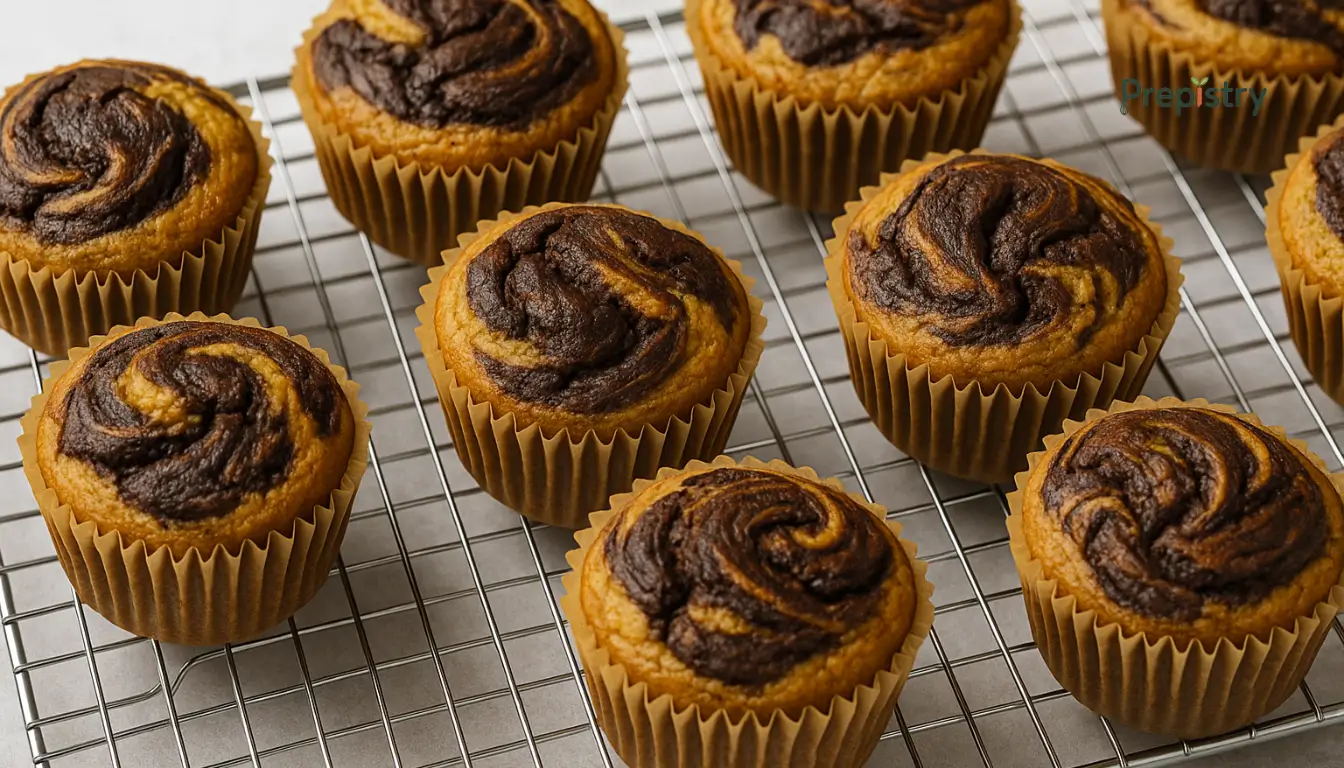
Nutrition Information
Equipment Needed
- Muffin tin
- Mixing bowls
- Whisk
- Measuring spoons
- Measuring cups
- Cooling rack
Ingredients
-
2 ripe bananas, mashed
-
1 cup whole wheat flour
-
1/2 cup cocoa powder
-
1/2 cup vanilla protein powder
-
1/4 cup honey or maple syrup
-
1/2 cup unsweetened almond milk
-
1 large egg
-
1 teaspoon vanilla extract
-
1 teaspoon baking powder
-
1/2 teaspoon baking soda
-
1/4 teaspoon salt
-
1/4 cup chocolate chips (optional)
Instructions
Recipe Video
Cocoa Banana Protein Swirl Muffins Recipe
Learn how to make these delicious and healthy cocoa banana protein swirl muffins. Perfect for a quick breakfast or snack!

